Acrachne
There are three species worldwide (Africa, SE Asia
and Australia) of which one (Acrachne racemosa) is native to
southern Africa. |
|
Acroceras
There are 19 species worldwide (Africa, Madagascar
and Indomalayan region) of which one (Acroceras macrum) is
native to southern Africa. |
|
Agrostis
There are about 220 species worldwide (in temperate
regions and at high altitudes in the tropics) of which 12 are native to southern Africa and two naturalised. |
|
Alloteropsis
There are about eight species worldwide (in the Old
World tropics) of which three are native to southern Africa. |
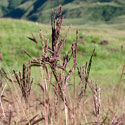 |
Andropogon
There are 100 species worldwide (pantropical) of
which 20 are native to southern Africa. |
 |
Andropterum One
species native to southern Africa - Andropterum stolzii (recorded
from Zimbabwe). |
|
Anthephora
There are 12 species worldwide (Africa, Arabia,
tropical America) of which four are native to southern Africa. |
|
Anthoxanthum
There are about 20 species worldwide (north
temperate regions, higher altitudes of tropical Africa and Asia) of which
about four are native to southern Africa and one is naturalised. |
|
Aristida
There are about 290 species worldwide (tropics and
subtropics) of which 36 are native to southern Africa. |
|
Arthratherum There are about seven species worldwide (Old World
Tropics) of which one (Anthraxon lanceolatus) is native to
southern Africa. |
|
Arthraxon
There are about seven species worldwide (Old World
Tropics) of which one (Anthraxon lanceolatus) is native to
southern Africa. |
|
Arundinella
There are about 50 species worldwide (tropics and
subtropics, mainly Asia) of which one (Arundinella nepalensis)
is native to southern Africa. |
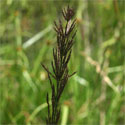 |
Bewsia
One species, Bewsia biflora, which is
native to Africa, including southern Africa. |
|
Bothriochloa
There are about 35 species worldwide (tropical
regions) of which three are native to southern Africa. |
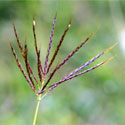 |
Brachiaria
There are about 100 species worldwide (tropics,
mainly Old World) of which 25 are native to southern Africa and one is naturalised. |
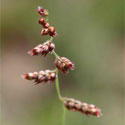 |
Brachyachne
There are about 10 species worldwide (Africa, Java
to Australia) of which two, Brachyacne fulva and Brachyachne patentiflora,
are native to southern Africa. |
|
Brachychloa
Two species, both native to southern Africa. |
|
Brachypodium
There are 16 species worldwide (native to
temperate Eurasia, tropical mountains, Mexico to Bolivia) of which three
are native to southern Africa and one naturalised. |
|
Briza (quake
grass, quaking grass, shaking grass) There are about 20 species worldwide (temperate
Eurasia, South America) of one is native to southern Africa and three naturalised. |

|
Bromus
There are about 150 species worldwide (north
temperate regions, tropical mountains, South America) of which five
are native to southern Africa and 10 naturalised. |
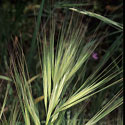
|
Calamagrostis
There are about 270 species worldwide (temperate
regions of both hemispheres) of which one
Calamagrostis epigeios
is native to southern Africa. |
|
Capillipedium
One species native to southern Africa, recorded from Zimbabwe -
Capillipedium parviflorum. |
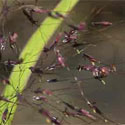 |
Catalepis
One species: Catalepis gracilis, which is
native to southern Africa. |
|
Cenchrus
There are about 22 species worldwide (native to tropical and warm temperate regions, with
two native to
southern Africa, and three naturalised. |
|
Centropodia
There are four species worldwide (native to
Africa and Middle East through to India) of which two are native to
southern Africa. |
|
Chaetobromus
One species, endemic to southern Africa:
Chaetobromus
involucratus |
|
Chloris
There are about 55 species worldwide (tropical and
warm temperate regions) of which seven are native to southern Africa
and one is naturalised. |
|
Chrysopogon
There are about 26 species worldwide (warm regions)
of which two, Chrysopogon serrulatus
and Chrysopogon nigritanus, are native to southern
Africa. In addition, Chrysopogon zizanioides is
cultivated in the region. |
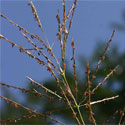 |
Cladoraphis
There are two species, both endemic to southern
Africa. |
|
Cleistachne
One species: Cleistachne sorghoides, distributed
through tropical Africa (including Mpumalanga in southern Africa) and
India. |
|
Coelachyrum
There are eight species worldwide (Africa, Arabian
Peninsula and Pakistan) of which one
Coelachyrum yemenicum is
native to southern Africa. |
|
Coelachne There are about 21 species worldwide (tropical
regons mainly) of which two, Coelorachis capensis
and Coelorachis afraurita (recorded from Zimbabwe), are native to
southern Africa. |
|
Coelorachis
There are about 21 species worldwide (tropical
regons mainly) of which two, Coelorachis capensis
and Coelorachis afraurita, are native to
southern Africa. |
|
Colpodium
There are about 20 species worldwide (native to
Africa and Middle East) of which one
Colpodium drakensbergensis
is native to southern Africa. |
|
Craspedorhachis
There are about five species worldwide (African and
American tropics) of which three are native to southern Africa. |
|
Ctenium
There are about 20 species worldwide (tropical and
subtropical America, Africa and Madagascar) of which two,
Ctenium
concinnum and Ctenium somalense (recorded from Zimbabwe),
are native to southern Africa. |
|
Cymbopogon
There are about 40 species worldwide (tropical and
subtropical Africa, Asia and Australia) of which seven are native to
southern Africa and one naturalised. Cymbopogon citratus (Lemon grass) is
cultivated in the region. |
|
Cynodon
There are about 10 species worldwide (warm climates)
of which eight are native to southern Africa and two are naturalised. Widely used for lawns and
sports grounds. |
|
Dactyloctenium
There are 13 species worldwide (warm regions) of
which four are native to southern Africa. |
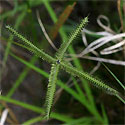 |
Danthoniopsis
There are about 20 species worldwide (Africa and
Arabian Peninsula) of which nine are native to southern Africa. |
|
Diandrochloa
There are about seven species worldwide (Americas,
Australia, Asia and Africa) of which two are native to southern Africa. |
|
Dichanthium
There are about 20 species worldwide (Old World
tropics) of which one species, Dichanthium annulatum (Blue grama),
is native to southern Africa, and Dichanthium aristatum
is naturalised. In addition, Dichanthium caricosum and
Dichanthium sericeum are cultivated in the region. |
|
Digitaria
There are about 230 species worldwide (cosmopolitan,
mainly tropical and warm temperate regions) of which about 40 are
native to southern Africa and four are naturalised. |
|
Diheteropogon
There are five species worldwide (indigenous
distribution limited to tropical Africa) of which two species are
native to southern Africa. |
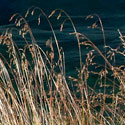 |
Dinebra
There are three species worldwide (Africa to India
and Madagascar) of which one Dinebra retroflexa is native to
southern Africa. |
|
Dregeochloa
The two species are endemic to southern
Africa. |
|
Echinochloa
There are 30-40 species worldwide (tropical and warm
temperate regions) of which 12 are native to southern Africa. |
|
Ehrharta
There are about 35 species worldwide (Africa and
Indonesia to New Zealand) of which 24 species are native to southern
Africa. |
 |
Eleusine
(Finger millet genus) There are nine species worldwide (Africa) of which
two are native to southern Africa and two are naturalised. |
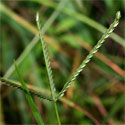 |
Elionurus
There are 15 species worldwide (cosmopolitan) of
which two species are native to southern Africa. |
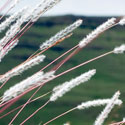 |
Elymandra
There are about six species worldwide (native to
tropical Africa) of which two species, Elymandra grallata
and Elymandra lithophila (recorded from Zimbabwe), are
native to southern Africa. |
|
Elytrophorus
There are about four species worldwide (tropical
Africa, Asia and Australia) of which two are native to southern Africa. |
|
Enneapogon
There are about 30 species worldwide (warm, dry
regions) of which six are native to southern Africa. |
|
Enteropogon
There are about 17 species worldwide (tropical
regions) of which three are native to southern Africa. |
|
Entolasia
There are five species worldwide (tropical Africa
and E Australia) of which two (Entolasia imbricata
and Entolasia
olivacea) are native to southern Africa. |
|
Entoplocamia
One species: Entoplocamia aristulata, which
within southern Africa is found in Namibia. |
|
Eragrostis
There are about 350 species worldwide (cosmopolitan)
of which 106 species are native to southern Africa and four species are
naturalised. |
|
Eriochloa
There 30 species worldwide (tropical regions) of
which six are native to southern Africa. |
|
Eriochrysis
There are about seven species worldwide (Africa,
India and tropical America) of which three are native to southern Africa. |
|
Euclasta Two
species globally (India, South America and tropical Africa), of which one is
native to southern Africa - Euclasta condylotricha (recorded from
Zimbabwe). |
|
Eulalia
There are about 30 species worldwide (tropical and
subtropical regions of Africa, Asia and Australia) of which two are
native to southern Africa. |
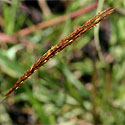 |
Eustachys
There are 10 species worldwide (tropics, mainly
America) of which one Eustachys paspaloides is native to
southern Africa. |
|
Festuca
There are about 450 species worldwide (temperate
regions and high altitude areas in the tropics) of which nine are
native to southern Africa and one naturalised. An additional two
species are cultivated in the region. |
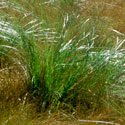 |
Fingerhuthia
There are two species worldwide (southern Africa,
Arabian Peninsula, Afghanistan), both of which are native to southern
Africa. |
|
Glyceria
One species native to southern Africa - Glyceria
maxima. |
|
Habrochloa
One species, Habrochloa bullockii, native to
tropical Africa (including Zimbabwe). |
|
Hackelochloa
There are two species worldwide (Africa, India, southern
China and southern USA) of which one Hackelochloa granularis is native to southern Africa. |
|
Harpochloa
There are two species worldwide (Africa) of which
one Harpochloa falx is native to southern Africa. |
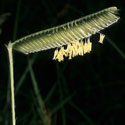 |
Helictotrichon
There are about 100 species worldwide (temperate
regions and tropics at high altitudes) of which 13 are
native to southern Africa. |
|
Hemarthria
There are 12 species worldwide (tropical and
subtropical regions of the Old World) of which one
Hemarthria altissima is native to southern Africa. |
 |
Heteropogon
There are about six species worldwide (tropics and
subtropics) of which two (Heteropogon contortus and
Heteropogon
melanocarpus) are native to southern Africa. |
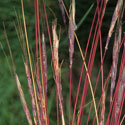 |
Holcus
There are six species worldwide (Europe, Africa and
Middle East) of which one (Holcus setiger) is endemic
to southern Africa and another (Holcus
lanatus) is naturalised in the region. In addition,
Holcus mollis is cultivated in the region. |
|
Hordeum
(Barley genus) There are about 40 species worldwide
(temperate regions) of which two are
native to southern Africa and four are naturalised species. Hordeum vulgare
(Barley) is cultivated in the region, mainly for beer production. |
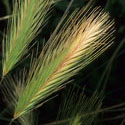 |
Hylebates The
two species are both native to tropical Africa, with one Hylebates
cordatus occurring in southern Africa (Zimbabwe). |
|
Hyparrhenia
There are about 55 species worldwide (mainly
Africa, also other tropical regions and the Mediterranean) of which
24 are native to southern Africa. |
|
Hyperthelia
There are six species worldwide (Africa) of which
one Hyperthelia dissoluta
is native to southern Africa (see
Flora of Zimbabwe). |
 |
Imperata
There are eight species worldwide (tropics and
subtropics) of which one Imperata cylindrica
is native to southern Africa. |
 |
Isachne There
are 50 species globally, with one Isachne mauritania occurring in
southern Africa (Zimbabwe). See
Flora of Zimbabwe. |
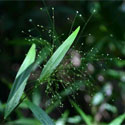 |
Ischaemum
There are about 60 species worldwide (tropics, mainly
Asia) of which three are native to southern Africa. |
|
Kaokochloa
One species: Kaokochloa nigrirostris endemic
to southern Africa (NW Namibia). |
|
Koeleria
There are 35-60 species worldwide (temperate regions) of which
one Koeleria capensis is native to southern Africa. |
|
Leersia
There are 18 species worldwide (tropics and warm
temperate regions) of which four
are native to southern Africa. |
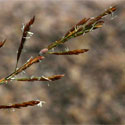 |
Leptaspis There
are five species worldwide of which one
Leptaspis zelyanica is native to
southern Africa (Zimbabwe and Mozambique). |
 |
Leptocarydion
One species: Leptocarydion vulpiastrum, which
occurs in eastern and southern Africa. |
|
Leptochloa
There are about 30 species worldwide (tropics and
subtropics) of which six are native to southern Africa. |
|
Lepturus
There are about 15 species worldwide (E Africa, Sri
Lanka, Polynesia to Australia) of which two,
Lepturus repens and Lepturus
radicans (recorded from Zimbabwe), are
native to southern Africa. |
|
Leucophrys
One species: Leucophrys mesocoma, endemic to
southern Africa (S Namibia to Northern Cape). |
|
Lintonia
There are two species worldwide (Africa) of which
one Lintonia nutans is native to southern Africa. |
|
Lophacme
There are two species worldwide (Africa) of which
one species, Lophacme digitata, is native to southern Africa. |
|
Loudetia
There are about 26 species worldwide (tropical
Africa, Madagascar and South America) of which seven are native to
southern Africa. |
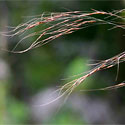 |
Loxodera There
are five species globally (tropical Africa) of which one Loxodera
caespitosa is native to southern Africa. |
|
Megaloprotachne
One species: Megaloprotachne albescens, endemic
to southern Africa (Namibia, Botswana and Northern Cape). |
|
Megastachya
One species: Megastachya mucronata, which
occurs in tropical areas of Africa and into southern Africa (KwaZulu-Natal
and Zimbabwe). |
|
Melica
There are 80 species worldwide (temperate regions,
excluding Australia) of which three are native to southern Africa. |
|
Melinis
There are 20 species worldwide (mainly Africa) of which
12 are native to southern Africa. |
 |
Merxmuellera
The 14 species are endemic to southern Africa. |
|
Microchloa
There are about five species worldwide (tropics), four of which are native to southern Africa. |
|
Microstegium
There are about 15 species worldwide (tropical Asia
and Africa) of which one Microstegium nudum
is native to
southern Africa. |
|
Miscanthus
There are about seven species worldwide (tropical and
southern Africa) of which two are native to southern Africa and one is
cultivated. |
|
Monelytrum
One species: Monelytrum luederitzianum, which
occurs from Namibia through to S Angola. |
|
Monocymbium
There are about four species worldwide (tropical and
southern Africa) of which one Monocymbium ceresiiforme
is native to southern Africa. |
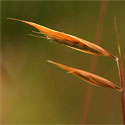 |
Mosdenia
One species: Mosdenia leptostachys, native to southern Africa (northern provinces). |
|
Nematopoa One
species: Nematopoa longipes, native to Zambia and Zimbabwe. |
|
Odontelytrum
One species: Odontelytrum abyssinicum, which
occurs from Ethiopia to southern Africa (Mpumalanga). |
|
Odyssea
There are two species worldwide (Africa) of which
one Odyssea paucinervis is native to southern Africa. |
|
Nematopoa One
species: Nematopoa longipes, native to Zambia and Zimbabwe. |
|
Olyra
There are 23 species worldwide (mainly tropics and
subtropics of America and Africa) of which one,
Olyra latifolia, is
native to southern Africa. See
Flora of Zimbabwe. Listed as naturalised in
POSA. |
|
Oplismenus
There are five species worldwide (tropics and
subtropics) of which four are native to southern Africa. |
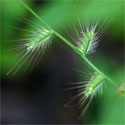 |
Oreobambos
One species,
Oreobambos buchwaldii
(Buchwa bamboo), recorded within southern Africa only from Mount
Buchwa in Zimbabwe (Palgrave and Palgrave 2002). |
|
Oropetium
There are about six species worldwide (arid regions of
India and Africa) of which one
Oropetium capense is native to
southern Africa. |
|
Oryza
(rice genus) There are about 25 species worldwide (tropics and
subtropics) of which three are native to southern Africa. Oryza
sativa (rice) has been cultivated in southern Africa, but most of the
rice eaten in the region is imported. |
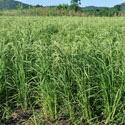 |
Oryzidium
One species: Oryzidium barnardii
(southern
tropical Africa, including southern Africa) |
|
Oxyrhachis
One species: Oxyrhachis gracillima, endemic
to southern Africa (southern KwaZulu-Natal and Eastern Cape). |
|
Oxytenanthera
One species: Oxytenanthera abyssinica
(Holy Venda bamboo, Bindura bamboo) (Africa, including southern
Africa). |
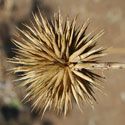 |
Panicum
(Common millet genus) There are about 470 species worldwide (tropical,
subtropical and warm temperate regions) of which 62 are native to
southern Africa.
Panicum miliaceum (Common
millet) is a domesticated species originating from Central Asia that
is grown to a limited extent in southern Africa and which has become
naturalised as well. |
 |
Paratheria
There are two species worldwide (Africa, Madagascar,
Cuba and Brazil) of which one Pantheria prostata is native to
southern Africa. |
|
Paspalidium
There are about 40 species worldwide (warm regions) of which
two are native to southern Africa. |
|
Paspalum
There are about 330 species worldwide (tropics,
predominately New World) of which five species are native to southern
Africa and four naturalised. In
addition, Paspalum nutans (native to tropical America) is
cultivated in the region. |
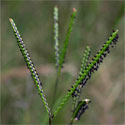 |
Pennisetum
There are about 80 species worldwide (warm regions) of which
11 are native to southern Africa and four are naturalised. An
additional species is cultivated in the region. Pennisetum glaucum
(Pearl
millet) is cultivated widely in Africa and India and is also
naturalised in southern Africa. Pennisetum clandestinum
(Kikuyu grass) is cultivated as a pasture grass and has also become naturalised. |
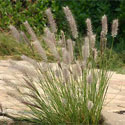 |
Pentameris
The nine species are endemic to southern Africa
(mountains of Western Cape and Eastern Cape) |
|
Pentaschistis
There are about 65 species worldwide (Africa and
Madagascar) of which 61 are native to southern Africa (mainly mountainous
regions). |
 |
Perotis
There are about 10 species worldwide (Africa to Asia
and Australia) of which three are native to southern Africa. |
 |
Petrina One
species native to southern Africa - Petrina parva. |
|
Phacelurus
There are about nine species worldwide (Africa to
Indo-China and Japan) of which one Phacelurus franksiae
is
native to southern Africa. |
|
Phyllorachis
One species: Phyllorachis sagittata (eastern and southern tropical
Africa). |
|
Phragmites
There are three species worldwide (cosmopolitan) of which
two are native to southern Africa (aquatic and semi-aquatic habitats). |
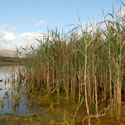 |
Poa
There are about 500 species worldwide (cosmopolitan) of which
three are native to southern Africa and three naturalised. An
additional species is cultivated in the region. |
 |
Poecilostachys
One species - Poecilostachys oplismenoides. |
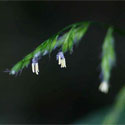 |
Pogonarthria
There are four species worldwide (Africa) of which
three are native to southern Africa. |
 |
Pogonochloa One
species: Pogonochloa greenwayi, native to Zambia and Zimbabwe. |
|
Polevansia
One species: Polevansia rigida, endemic to
southern Africa (Lesotho, Eastern Cape). |
|
Polypogon
There are about 18 species worldwide (tropics and
warm temperate regions) of which one are native to southern Africa and two
are naturalised. |
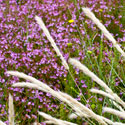 |
Prionanthium
The three species are endemic to the Western Cape, South
Africa. |
|
Prosphytochloa
One species:
Prosphytochloa prehensilis, native to southern Africa. |
|
Pseudechinolaena
There are six species worldwide, five are endemic to
Madagascar and the other has a pantropical distribution that includes southern Africa. |
|
Pseudopentameris
The four species are endemic to the Western Cape,
South Africa. |
|
Puccinellia
There are about 80 species worldwide (mainly north
temperate regions) of which two are native to southern Africa and two
are naturalised. |
|
Rendlia
One species: Rendlia altera, found in the
high eastern regions of southern Africa. |
|
Rhytachne
There are 12 species worldwide (Africa, Madagascar
and South America) of which three are native to southern Africa. |
|
Rottboellia
There are four species worldwide (tropical and
subtropical Africa and Asia) of which one
Rottboellia cochinchinensis
is native to southern Africa. |
 |
Rytidosperma
Ninety species in distributed across Australia, New Zealand and Africa, of
which two are native to southern Africa: Rytidosperma davyi and
Rytidosperma disticha (recorded from Zimbabwe). |
|
Sacciolepis
There are 30 species worldwide (tropics, mainly Africa)
of which nine are native to southern Africa. |
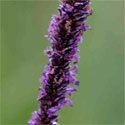 |
Sartidia
There are four species worldwide (Africa and
Madagascar) of which two are native to southern Africa. |
|
Schismus
There are six species worldwide (Africa,
Mediterranean region to NW India) of which five are native to southern
Africa. |
|
Schizachyrium
There are about 60 species worldwide (tropics) of which
seven are native to southern Africa. |
|
Schmidtia
There are three species, all native to southern
Africa, but the genus occurs elsewhere in Africa and in Pakistan. |
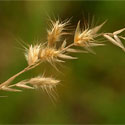 |
Schoenefeldia
There are two species worldwide (Africa, Madagascar
and India) of which one Schoenefeldia transiens is native to
southern Africa. |
|
Secale
(Rye genus) There are about five species worldwide
(Mediterranean, E Europe, central Asia) of which one is native to
southern Africa. Secale cereale (Rye) is a domesticated species originating
from E Turkey and Armenia that is cultivated to produce grain low in gluten and used in
rye bread, crispbreads, and some alcoholic spirits (e.g. some whiskeys made in the USA, gin
and some types of vodka). |
|
Sehima
There are seven species worldwide (Africa, India and
Australia) of which two (Sehima galpinii and
Sehima ischaemoides)
are native to southern Africa. |
|
Setaria
There are about 110 species worldwide (tropics and
subtropics) of which 22 are native to southern Africa and two are naturalised. There is an additional species that is cultivated in the region. Includes
Setaria italica
(Foxtail millet), which
was domesticated in East Asia over 7000 years ago and is now
cultivated to a minor extent, mainly for producing bird seed. |
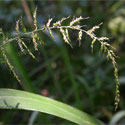 |
Sorghastrum
There are about 20 species worldwide (mainly tropics
and subtropics of America and Africa) of which two (Sorghastrum nudipes and Sorghastrum stipoides) are native to
southern Africa. In addition, Sorghastrum nutans
(Indian grass), which is native to the North American prairies, is
cultivated in the region. |
|
Sorghum
(Sorghum genus) There are about 24 species worldwide (tropics and
subtropics of the Old World) of which two are native to southern
Africa and one is naturalised. Sorghum bicolor (Sorghum) is
one of the indigenous species and has domesticated varieties grown as crops. |
|
Spartina
There are about 16 species worldwide (temperate
America, coastal Europe and Africa) of which one
Spartina maritima
is native to southern Africa (found along edges of estuaries along the coast of Namibia, the
Western Cape and Eastern Cape). |
|
Sporobolus
There are about 160 species worldwide (tropical and
warm temperate regions) of which 47 are native to southern Africa. |
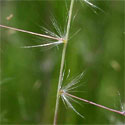 |
Stenotaphrum
There are seven species worldwide (tropics and
subtropics) of which two (Stenotaphrum secundatum and
Stenotaphrum dimidiatum) are native to southern Africa. |
|
Stereochlaena
There are five species worldwide (tropical East
Africa to South Africa) of which one Stereochlaena cameronii
is
native to southern Africa. |
 |
Stiburus
The two species are endemic to southern Africa. |
|
Stipa
There are about 300 species worldwide (tropical through
to temperate regions) of which two are native to southern Africa. |
|
Stipagrostis
There are about 50 species worldwide (Africa, NW
India and SW Asia) of which 29 are native to southern Africa. The San people
are known to collected and eat wild seeds of Stipagrostis
uniplumis and
Stipagrostis brevifolia. |
 |
Streblochaete
One species:
Streblochaete longiarista (tropical
Africa, Réunion, Indonesia, Philippines). Within southern Africa it
occurs in the Eastern Cape. |
|
Styppeiochloa
There are two species worldwide (mountains of south
and southeast tropical Africa) of which one
Styppeiochloa gynoglossa
is native to southern Africa. |
|
Tarigidia
One species: Tarigidia aequiglumis, endemic
to southern Africa. |
|
Tetrachne
One species: Tetrachne
dregei, endemic to
southern Africa. |
|
Tetrapogon
There are five species worldwide (Middle East, India
and Africa) of which one Tetrapogon tenellus is native to
southern Africa. |
|
Thamnocalamus
There are about six species worldwide (E Asia,
Africa) of which one Thamnocalamus tessellatus
(Drakensberg bamboo) is native to
southern Africa. |
|
Thelepogon
One species: Thelepogon elegans (tropical
Africa through to Indonesia). Within southern Africa it occurs in the
Caprivi (Namibia). |
|
Themeda
There are 18 species worldwide (Old World tropics
and subtropics, mainly Asia) of which one
Themeda triandra is native to
southern Africa. |
 |
Trachypogon
There are 13 species worldwide (Africa, Madagascar
and tropical America) of which one Trachypogon spicatus
is
native to southern Africa. |
|
Tragus
There are seven species worldwide (tropics, mainly
Africa) of which four are native to southern Africa. |
 |
Tribolium
The 13 species are endemic to southern Africa. |
 |
Tricholaena
There are four species worldwide (mainly Africa,
also Canaries, Mediterranean and Madagascar) of which two are native to southern Africa. |
|
Trichoneura
There are seven species worldwide (Africa, Arabian
Peninsula, USA) of which two are native to southern Africa. |
|
Trichopteryx
There are five species worldwide (Africa and Madagascar)
of which three are native to southern Africa. |
|
Tripogon
There are about 30 species worldwide (tropical
Africa, India, Australia) of which one Tripogon minimus is
native to southern Africa. |
|
Triraphis
There are seven species worldwide (Africa, Arabian
Peninsula, one in Australia) of which five are native to southern
Africa. |
|
Tristachya
There are about 22 species worldwide (tropical
Africa and America, Madagascar) of which seven are native to southern
Africa. |
 |
Urelytrum
There are seven species worldwide (tropical Africa) of which
one Urelytrum agropyroides is native to southern Africa. |
|
Urochloa
There are about 12 species worldwide (Old World
tropics) of which six are native to southern Africa. Bushveld
signal grass Urochloa mosambicensis is used as a cereal in
rural areas of southern Africa. |
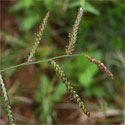 |
Vossia
One species: Vossia cuspidata (tropical
Africa and India). Within southern Africa it occurs in Namibia (Caprivi)
and N Botswana. |
|
Vulpia
There are about 23 species worldwide (temperate
regions, mainly Mediterranean) of which one is native to southern
Africa, and four naturalised. |
|
Willkommia
There are four species worldwide (tropical Africa,
USA) of which three are native to southern Africa (N Namibia, Botswana). |
|
Zonotriche
There are three species distributed across tropical Africa, of which one
Zonotriche inamoena is native to southern Africa (Zimbabwe). |
|
